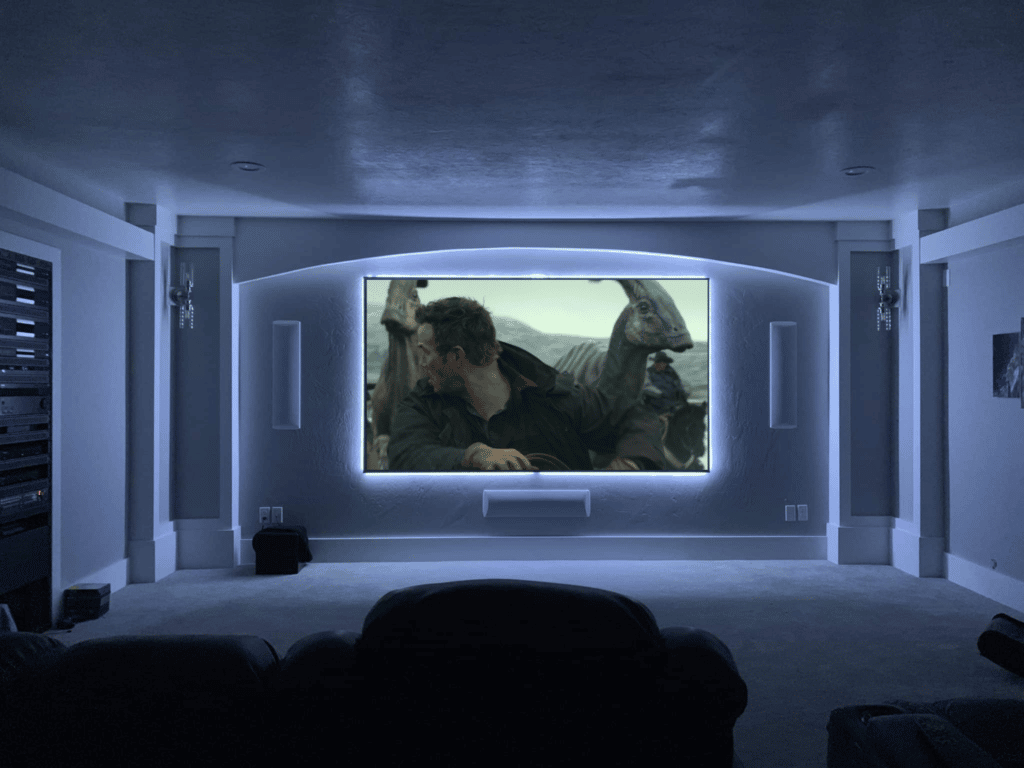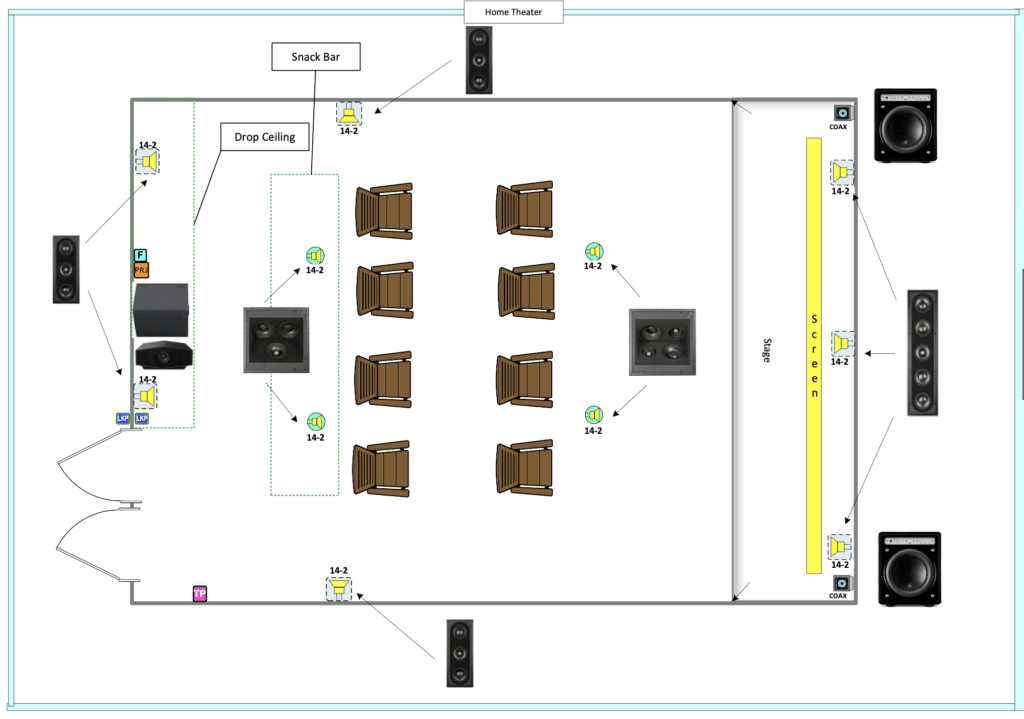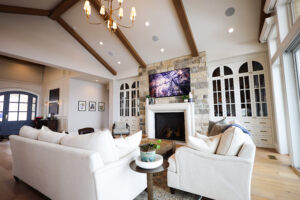A home theater setup is more than a big screen and a comfortable couch. To truly achieve the ultimate movie-watching experience, it’s essential to understand the basics of home theater setup and why it can’t just be “winged.”
From professional integrations to ensure proper functionality to consultations for an optimized system, here’s advice on the best home theater setup from the AIS pros.
Home Theater Setup Essentials
To create the perfect home theater setup, a list of equipment essentials must be professionally installed and customized for your home. If any of these steps are done improperly, you could risk incompatibility or functionality issues — which can be costly to replace and reintegrate.
Below we’ll break down the must-haves of a home theater setup.
Surround Sound System
For cinephiles, Dolby Atmos should be at the top of your home theater must-haves. It’s superior to standard surround sound speakers because it brings a rich and dynamic audio experience. With its ability to produce a 360-degree sound field via multiple speakers, Dolby Atmos will transport you right into the heart of the action. Dolby Digital is the secret ingredient that elevates the home theater experience to new heights. So, if you want to take your movie nights to the next level, Dolby Atmos is non-negotiable.
High-End Projector and Screen
Investing in a high-end projector and projector screen is crucial for creating a truly immersive and dedicated home theater experience. A top-quality projector delivers bright, vivid, and accurate colors with deep blacks and vibrant whites. It should produce a sharp and detailed image free of distortion and noise — giving you a cinematic experience like no other. We highly recommend Sony projectors as they’re the highest-quality projector available on the market.
Similarly, a projector screen should enhance your viewing experience by providing a larger, more immersive image with optimized contrast and color reproduction. For screens, we highly recommend Screen Innovations to provide the highest quality visual to pair with a Sony projector.

Ambient Lighting Control
Investing in ambient lighting control is vital to creating an exceptional home theater setup. Proper lighting can significantly enhance your viewing experience by reducing eye strain and improving picture clarity.
Some ambient lighting options include the following:
- Dimmable Overhead Lighting — standard ceiling lights with brightness control
- Accent Lighting — highlights key features, such as artwork or architectural elements
- Mood Lighting — LED lights that change color to fit a particular mood or synchronize with the movie’s visuals
- Wall Sconces — wall-mounted, upward-facing lights provide soft lighting throughout the room
These are a few home theater lighting ideas to consider. For more information about ambient lighting options and how to set up the ultimate human-centric lighting conditions, contact AIS for a consultation to find the best option.
Luxury Seating
Finally, adding luxury seating to your home theater setup is essential. It’s worth investing in comfortable seating for a home theater if you plan to spend much time there or host guests. Luxury seating provides maximum comfort, back support, and style to enjoy your favorite entertainment while fitting your aesthetics. Many luxury seating options exist, from recliners to full-fledged home theater seating, to create your dream home movie-watching experience.
As a bonus tip, a home theater can be repurposed as a game room for homeowners with children or for video game enthusiasts. Luxury seating is a practical option in a home theater for movies, video games, and TV streaming.

Home Theater Setup Dos and Don’ts from the AIS Pros
Now that you know the home theater essentials, here are the dos and don’ts of setting one up straight from the AIS pros.
Do: Install In-Wall, In-Ceiling, or Hidden Speakers
In-wall and in-ceiling speakers are perfect for creating an integrated and sleek home theater design. These speakers are discreetly mounted within the walls or ceiling to blend seamlessly into the room. They deliver powerful and accurate sound without taking up valuable floor or shelf space — ideal for smaller rooms or those who want a minimalist look.
Don’t: Setup Standing or Wireless Speakers
While there are some exceptional standing tower speakers, the issue is that most tend to be bigger, which can be visually distracting in a home theater — especially if you’re setting up surround sound speakers too. For wireless speakers, the sound quality may become choppy from signal interference or device malfunctions.
We always recommend a wired home automation setup with high-quality home theater speaker brands such as James Loudspeaker, Monitor Audio, and Sonance.
At AIS, our custom system integrators can install in-wall or in-ceiling speakers to maximize your space and ensure they’re properly integrated due to the complex home theater wiring requirements. We ensure that all wires are hidden, labeled, and neatly organized to expand your home theater automation in the future easily.
Do: Invest in a High-End Projector or Smart TV
One of the essential elements of a home theater setup is the display device, whether it’s a projector or a TV. It’s crucial to properly research the differences between projectors vs. TVs to see which is the best option for your home theater.
A high-end projector or OLED TV will provide better picture quality, color accuracy, and brightness than a budget-friendly option. Investing in a high-quality display device will help to future-proof your home theater setup, as new smart home technologies and features will become available over time.
As a bonus tip, we recommend using Kaleidescape as to elevate your projector or smart TV’s streaming as their platform is designed for home theaters.
Don’t: Purchase a Smart TV or Projector Without Proper Measurements from Professionals
A common mistake homeowners make when creating a home theater is purchasing a TV or projector without proper measurements. This can lead to a display device that is too large or small for the room, resulting in an unsatisfactory viewing experience, such as eye strain or constricting space.
At AIS, our home theater integrators measure the room for homeowners to minimize these equipment-distancing mistakes. This includes measuring the space where the TV or projector will be placed, including the distance from the viewing area to the screen or wall. They’ll ensure your home theater setup has the optimal distance between your equipment to optimize the space to recommended viewing distance standards.
Check out our home theater setup diagram below to get a visual reference of TV viewing distance recommendations.

Do: Install Proper Soundproofing
Proper soundproofing is critical for creating a fully immersive home theater setup. Without proper soundproofing, outside noise can leak into your room and disrupt your enjoyment of your favorite movies or shows. Sound from your home theater system can also disturb other household members or neighbors.
Soundproofing a home theater includes the following:
- soundproofing materials to the walls and ceiling
- installing soundproof doors
- using soundproof window treatments
Additionally, consider adding acoustic panels to your room to absorb excess sound and improve the overall sound quality of your system.
Don’t: Use Cheap Soundproofing Products
While it may be tempting to go for the most affordable soundproofing products available, this mistake can seriously hinder the performance of your home theater setup. Consumer-grade soundproofing products often have limited effectiveness and may not provide the level of soundproofing that you need.
Talk to one of our professional team members to get home theater recommendations on the best soundproofing products for your specific needs.
Home Theater Setup FAQs
Are there limits when planning a home theater setup?
There are five major limitations homeowners must consider when planning a home theater:
- Room Size — determines the number of speakers, speaker types, speaker location, acoustics, screen size, screen type, or projector model required
- Ceiling Height — impacts acoustics as higher ceilings and flat surfaces produce more echoes (acoustic panels, carpets, and rugs help absorb sound)
- Windows — light largely impacts home theaters and creates TV glares (motorized blackout shades can make this a non-factor)
- Weak Internet Connection— disrupts streaming with poor connection
- Network or Router Distance —requires a close access point for Wi-Fi products (ethernet wiring eliminates distance requirements and Wi-Fi connection issues)
Whether you’re retrofitting a home theater or its new home integration, these limits must be considered when planning a home theater.
What’s best to plan first for a home theater setup?
This depends on many factors. Homeowners can nail down exact wire locations once they know which speakers they plan to purchase. The home theater setup process is all planned at the same time.
When planning a home theater, it’s mainly about the experience you want to have, how you want it to work, and what you want it to look/feel like. Buying a bunch of speakers and equipment with no plan can lead to poor results. Decide what you want to experience, contact home theater integrators, get their product recommendations, and plan ahead so they can prewire. When you have that vision, and everything is wired right, the installation and finish trim can be planned around that.
What’s the biggest mistake when planning a home theater setup?
The biggest mistake homeowners make in their home theater setup results from not using custom system integrators for consultations and installation. If homeowners go the home theater DIY route or use electricians who aren’t specialized in home theater integration, it can risk functionality and quality issues.
What are the risks of not using integrators for a home theater setup?
Some risks homeowners face not using custom system integrators for their home theater setup are:
- running the wrong wire
- running wire in the wrong spot
- plugging things incorrectly into devices
- poor speaker placement
- wrong amount of speakers
- no subwoofer
- wrong screen or projector size
- poor viewing distance
- cluttered space
These mistakes can lead to high replacement costs, which can be avoided by using home automation professionals. At AIS, our integrators are HTA-certified to provide homeowners with the highest quality home automation standards and services.
Plan the Proper Home Theater Setup with AIS
Now that you know our guide to a home theater setup, the next step is to hire system integrators to bring it to life. Whether you want to upgrade your living room or install your first home theater, our home theater integration services can help guide and install it for you.
Use our budget calculator for an estimate for new construction and retrofits, or contact AIS for help deciding the best home theater setup today!
Related Blog Posts:
Home Theater Streaming Surround Sound: Netflix +4 Streaming Services Analyzed



